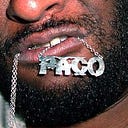Interesting read, J.C., reflecting a very respectable amount of research.
I’ve been fascinated with King Kong and Godzilla since I was a kid in the 1970s, and have written quite a bit about both.
What I haven’t yet written, though, is the essay to accompany the title in my head “Was the King King Movie Racist?” Or some version of that title that will allow me to offer my own insights on a topic that I still haven’t seen anyone adequately explore.
Well, to my satisfaction anyway.
Some years ago, Quentin Tarantino was interviewed on NPR’s Fresh Air––if memory serves me––and he was going on and on about different films he admired and the importance of viewers being able to discern and interpret subtext.
He then went on this tear about King Kong, talking about all of the racist sub-text in the film aimed at African American people––or Black men in particular. Racist subtext that isn’t even there.
"There's no there there," as it were.
Quentin’s take, like that of nearly all other theorists of European descent, is a product of confirmation bias.
The embrace of the Nazi film censor Dr. Ernst Seeger’s take that you've cited in your piece is a great example of that confirmation bias at work.
Along with him, I’ve seen others who’ve tried to seize on the same wrong-headed notion that places a false premium on the value of a white woman's life over the lives of the tribal women of Skull Island.
But here’s the gag.
Why would the inhabitants of Skull Island have a ginormous stone altar––replete with chiseled ornamentation––if they hadn’t *already* been making sacrifices of their own women to the demigod that roamed outside their village walls?
A stone altar couldn't have been erected and adorned with chiseled ornamentation overnight.
What's even more hilarious about that absurd take is that when the Skull Islanders first make an appearance in the film, they are in the process of preparing the next young "Bride of Kong" to be sacrificed.
Ann Darrow was nothing more than the very first offering of white meat.
And also someone who wasn’t, you know, a beloved member of the family that had to be sacrificed to the beast.
The hilarious irony of it all is that she meant nothing to them.
And it’s only an absurd belief in white exceptionalism that could make anyone think that nothing of consequence had ever taken place on Skull Island until Carl Denham arrived there with a pretty white woman in tow to experience it.
You know, like Christopher Columbus "discovering" a whole continent upon which several thousand human beings had lived for multiple millennia before he got there...in his poorly planned shortcut to India.
To be quite fair, though, that same racist confirmation bias exists within the film’s script itself, which I briefly discussed in one of my Kong essays. It’s that part in the film when Denham and Co. arrive on Skull Island and he says something about the current inhabitants having “slipped back” culturally.
This dude just literally got off the boat, has set foot on Skull Island for the very first time, hasn't even seen a Skull Islander before, and couldn't speak their language.
But he’s an expert on their cultural history.
Only within the culture of white exceptionalism (which I purposely choose to use here as a pleasant euphemism for white supremacy) can it be easy to not question Denham’s perspective on the Black inhabitants of Skull Island. Not for a moment.
I mean, sure. There's the suspension of disbelief for a film about a giant ape and dinosaurs still inhabiting a distant island in the Indian Ocean in the 20th century, but then there's that.
Anywho, the actual monster in King Kong wasn’t Kong at all. And it wasn’t beauty that killed the beast.
It was Western Imperialism.
But of course, the actual monster of the film that dragged poor King Kong away from his mist-covered island home couldn’t be seen as such.
I mean, these were the same people…well, the modern cultural benefactors of those who'd chained African peoples into the bowels of countless ships and then dragged them into enslavement on agricultural plantations across the Americas.
The same people who, in the 20th century, forced "lions and tigers and bears" into cages for entertainment and profit.
No. Not them.
They could never be seen as the monster.
But the good thing about a piece like yours is that it accurately drives home the point that the monsters in films like Frankenstein, Godzilla, and King Kong, do perfectly reflect the cultures that created them.
The bad thing, though, is that we've never been able to see the monster that's actually reflected in King Kong's cinematic looking-glass.
